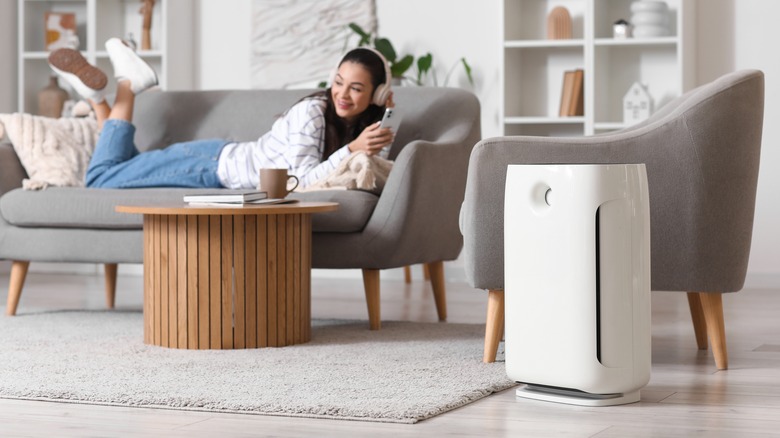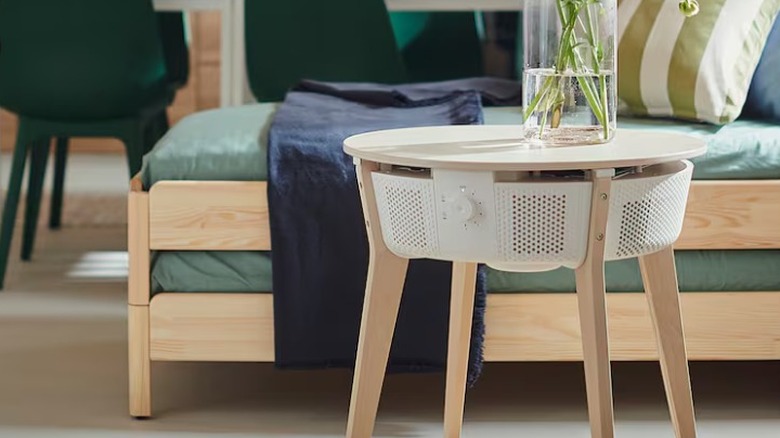The IKEA Air Purifier That Seamlessly Blends Into Your Home Decor
The STARKVIND table is a favorite IKEA smart home device that can improve your lifestyle. You get to use its top as an end table in your living room or a nightstand in your bedroom. Simultaneously, the AHAM-certified built-in air purifier improves your IAQ (indoor air quality) by trapping dust, tobacco smoke, mold spores, pet dander, and pollen. Plus, you can turn it on, set timers, and adjust the fan speed remotely via the IKEA Home smart app. The best part? You can hide its cable in one of its table legs to seamlessly blend it into your home décor. Despite all these benefits, is it the best air purifier for your home?
House Digest spoke exclusively to Michael Rubino, a mold and air quality expert, environmental wellness advocate, and founder of HomeCleanse. He's also the host of the "Never Been Sicker" podcast and chair of Change the Air Foundation. Impressed by STARKVIND's design, he opines, "It's really encouraging to see large companies like IKEA thinking about how to make functional furniture that serves the public and addresses the growing epidemic of poor indoor air quality."
Discussing the purifier's prowess, he says, "IKEA uses an E12 filter ... It can trap at least 99.5% of particles between 0.1 and 0.3 microns in size. That's pretty solid, especially for a $199 device that also works as a table." Although impressive, there are better air purifiers for your home that won't break the bank. "For example, H13 and H14 filters — which are considered true HEPA under the same European system — can capture 99.95% and 99.995% of those tiny particles, respectively," he says.
Pros and cons of IKEA's STARKVIND table with air purifier
IKEA's STARKVIND comes with a PM2.5 particle filter, helping it capture large particles that degrade your home's IAQ. However, you'll have to spend extra for a gas filter if you want the device to filter out harmful gases and nanoparticles as well. Rubino agrees and mentions in his House Digest exclusive, "Without the upgraded filter, the initial model will just filter out particles, not gases such as VOCs ... Ultrafine particles, like some viruses, will not be filtered as they can be as small as 0.003 microns." But that doesn't mean it's completely useless. Elaborating on its pros, he explains, "If you need a side table, you might as well have one that's cleaning the air. The price is right for the type of filter it uses and the functionality it offers."
However, don't think that it's enough to filter the pollutants from your indoor air. "The device claims to operate between 32 CFM and 158 CFM, depending on the setting," says Rubino. "At its highest setting, it can clean 9,480 cubic feet per hour. A 20x10 living room with 8-foot ceilings is about 1,600 cubic feet, so this results in almost 6 air changes per hour — which is great." On the flip side, "At its lowest setting, it only cleans 1,920 cubic feet per hour, meaning that same living room gets just about 1 air change per hour." Since a device must offer a minimum of four air changes every 60 minutes, you must either dial up the fan speed for it to work efficiently or opt for a different device altogether.
Important things to consider when choosing an air purifier
There are certain factors you should consider when choosing the right air purifier to get rid of mold spores. In his exclusive interview with House Digest, Rubino suggests determining "filter performance, the types of particles the filter can remove, and how many air changes per hour it provides in a particular space. (Even the best filter isn't effective if it isn't moving enough air through it, resulting in poor air changes per hour.)"
Start by checking whether the device meets HEPA standards. Then, look at its air filtration capacity. "Units capable of capturing particles smaller than 0.3 microns can offer even better air cleaning performance," says Rubino. Go through customer reviews to ensure it offers consistent results. Moreover, pay attention to the kinds of particles and gases it traps. "A carbon filter is especially useful for capturing gases like volatile organic compounds (VOCs), so having this extra layer is a smart addition for more comprehensive protection," he recommends. Don't forget to account for the amount you'd have to spend on your air purifier's replacement filters.
You also want to pick a model that's compatible with your room size. Clarifying the logic behind this, Rubino says, "If the space you're trying to purify is larger than what the unit can manage, it won't perform effectively." Since these devices work round-the-clock, ensure it comes with Energy Star Certification so your utility bills don't skyrocket. Amidst all this, don't overlook the smart features or add-ons, such as "filter replacement indicators, built-in air quality sensors, portability enhancements like wheels or handles, smart home integration, and remote control functionality."


